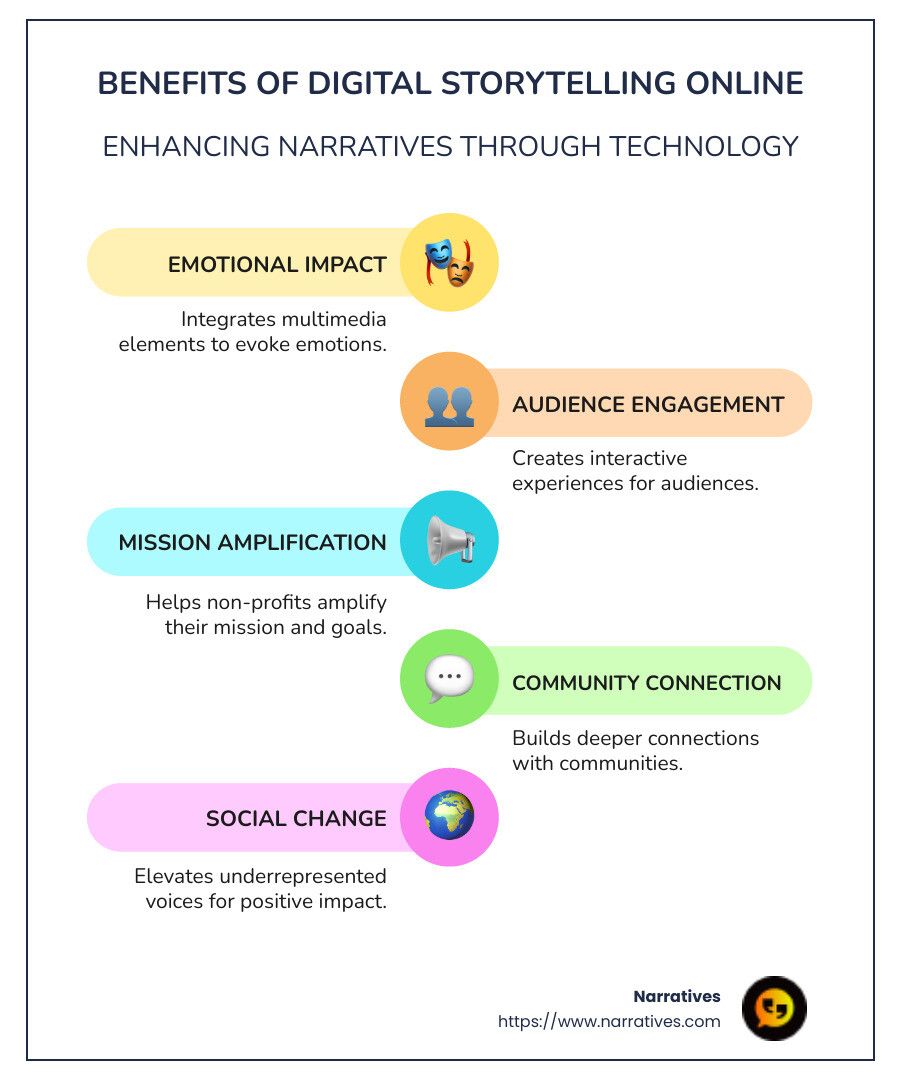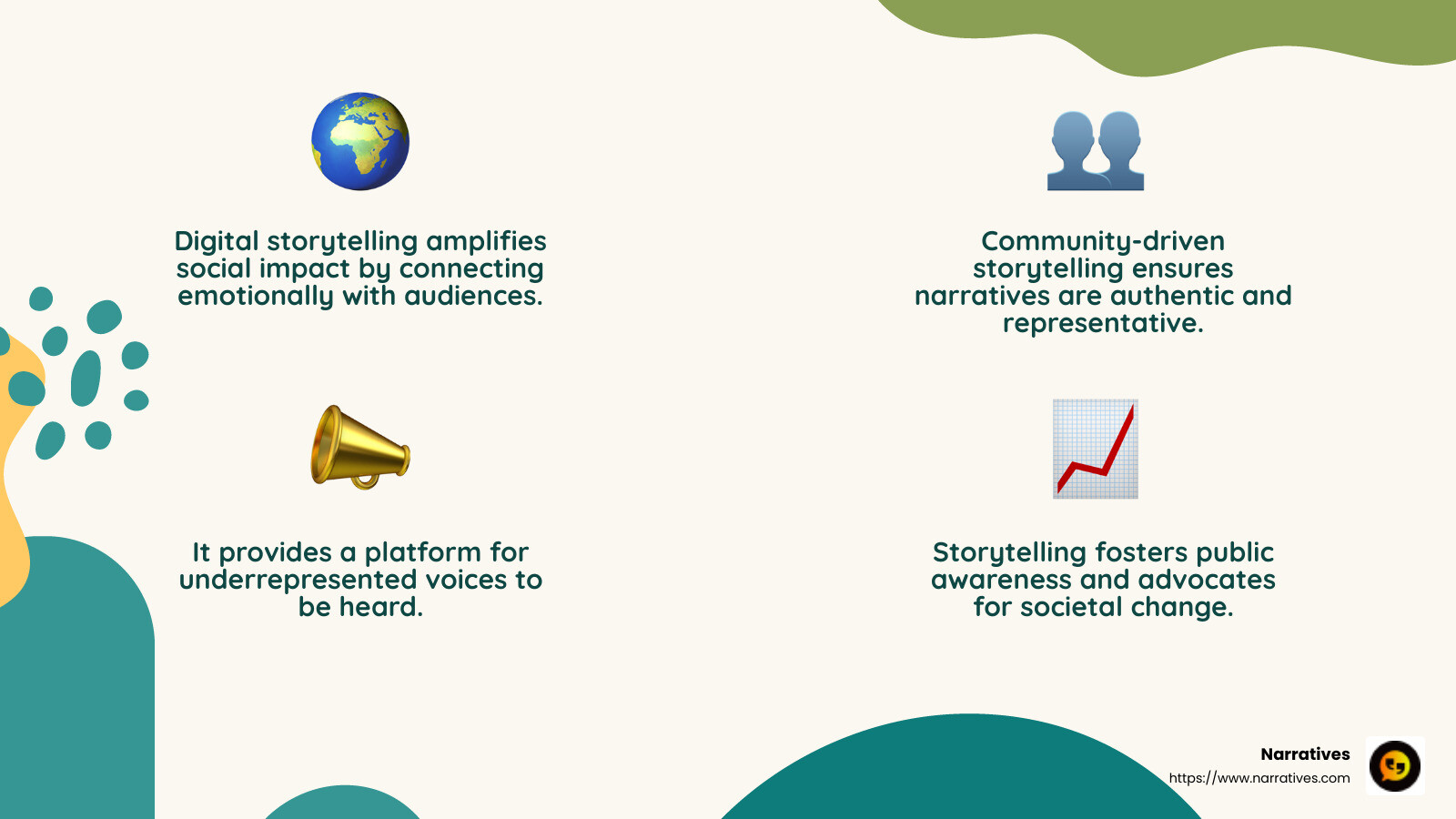From Screen to Story: Exploring Digital Storytelling Online

Digital storytelling online is changing how organizations and individuals convey narratives to engage and inspire audiences. With the integration of multimedia elements like graphics, videos, and interactive content, storytelling has evolved beyond traditional methods. This allows for more immersive and emotionally impactful experiences.
- Digital storytelling online:
- Combines traditional storytelling with digital technology.
- Improves narratives using multimedia tools.
- Offers interactive and engaging audience experiences.
The blend of digital tools with storytelling opens new avenues for expressing complex ideas in relatable ways, making it particularly valuable for non-profits and socially-driven brands. These groups often seek to amplify their mission and connect with communities on a deeper level. Digital storytelling provides the means to craft compelling, multimedia-rich narratives that resonate with audiences, driving awareness and action.
Recent advancements demonstrate that well-told digital stories can inspire loyalty and even spark social movements. As such, organizations that focus on advocacy or social justice can use digital storytelling to lift underrepresented voices and create meaningful change.

Glossary for digital storytelling online:
The Evolution of Digital Storytelling
Digital storytelling has come a long way from simple text narratives. Today, interactive content and multimedia experiences are at the forefront, changing how stories are told and experienced. This evolution is driven by the need to engage audiences more deeply and make stories more memorable.
The Power of Interactive Content
Interactive content allows audiences to participate in the storytelling process. This engagement can be achieved through clickable elements, decision-making paths, or even real-time interactions. For instance, platforms like StoryMap JS enable users to layer information over geographic maps, creating a narrative journey that's both educational and engaging.
- Benefits of Interactive Content:
- Improves user engagement by making them active participants.
- Provides personalized experiences based on user choices.
- Increases retention by involving multiple senses.
Multimedia Experiences
Multimedia experiences combine text, images, video, and sound to create rich, immersive stories. This approach caters to different learning styles, making content more accessible and impactful.
- Examples of Multimedia Tools:
- Adobe Spark: Ideal for visual-heavy stories, offering ready-to-use images and templates.
- Canva: Offers beautiful templates for infographics and social media posts, making anyone feel like a graphic designer.
These tools help storytellers craft visually appealing narratives that capture attention and convey messages effectively.
Storytelling Platforms
Storytelling platforms are the backbone of digital storytelling online. They provide the necessary infrastructure to create, share, and experience stories in innovative ways. These platforms range from simple blog sites to complex interactive tools that offer a variety of features.
- Key Features of Storytelling Platforms:
- Support for multimedia integration.
- User-friendly interfaces for easy content creation.
- Options for collaboration and sharing.
Interactive timelines, like those created with Timeline JS, add a chronological dimension to storytelling, allowing users to explore events in sequence and gain a deeper understanding of the narrative flow.
The evolution of digital storytelling not only improves how stories are told but also how they are received. By leveraging interactive and multimedia elements, storytellers can create engaging experiences that resonate with audiences on a personal level. This change is particularly beneficial for non-profits and organizations focused on social impact, as it allows them to amplify their messages and connect with their communities in meaningful ways.
Digital Storytelling Online: Tools and Techniques
In digital storytelling online, a variety of tools and techniques have emerged to help creators craft compelling narratives. These tools range from storyboard software to interactive timelines, each offering unique features to improve storytelling. Let's explore some of these free tools and apps that make digital storytelling accessible to everyone.
Free Digital Storytelling Tools
ACMI Generator: This creative studio space allows users to explore and create moving image works. The Storyboard Generator feature lets you build and share your own storyboards, making it an excellent choice for visual storytelling.
Bubblr: Create comic strips using photos from Flickr. Add speech bubbles to your photo sequence to tell a story in a fun and engaging way.
Capzles: Combine videos, photos, music, and documents to create rich multimedia experiences. This tool is perfect for those who want to weave multiple media into a single narrative.
Comic Master: Design your own short graphic novel. Choose backgrounds, characters, and props to build scenes, adding dialogue and captions to bring your story to life.
MakeBeliefsComix: An easy-to-use platform for creating comic strips. Select characters, add backgrounds, and use talk balloons to develop your story.
MapSkip: Mark locations on Google Maps with stories and photos. This tool is great for geographic storytelling, allowing you to connect narratives to real-world places.
PicLits: Match beautiful images with keywords to inspire creative writing. This site encourages users to capture the essence of a picture through words.
Slidestory: Combine slideshows with voice narration. Each slide can have an audio file, making it an exciting way to present stories.
Smilebox: Create slideshows, invitations, and photo albums with customizable templates. Add music and comments to personalize your creations.
Storybird: Turn curated artwork into visual stories. While sharing stories is free, downloading or printing them may incur a fee.
ZooBurst: Build 3D popup books online. Customize your book with characters and props from a vast database, or upload your own artwork.
Apps for Digital Storytelling
Adobe Slate: Create visually stunning stories with ease. This app is ideal for turning ideas into beautiful narratives using photos and text.
Puppet Pals: An interactive app for creating animated stories. Choose characters and backgrounds, then record your voice to bring the story to life.
ShowMe Interactive Whiteboard: A digital whiteboard app that allows you to draw, write, and record voiceovers. It's perfect for educational storytelling.
Sock Puppets: Create lip-synced videos with sock puppet characters. Record your voice and watch your puppets animate to your story.
Toontastic: A fun app for kids to draw, animate, and narrate their own cartoons. It's a playful way to encourage creativity and storytelling.
WeVideo: A cloud-based video editing app that makes it easy to create and share videos. With a variety of editing tools, it's great for crafting video stories.
30hands Starter: An app for creating simple presentations with images and voiceovers. It's user-friendly and perfect for beginners in digital storytelling.
These tools and apps provide a wide array of options for anyone looking to dive into digital storytelling online. Whether you're creating a comic strip, a multimedia presentation, or an interactive map, these resources can help bring your stories to life in engaging and imaginative ways.
Benefits of Digital Storytelling for Non-Profits
Digital storytelling offers non-profits a powerful way to amplify their social impact. By using digital storytelling online, organizations can craft narratives that resonate with their audience, drive engagement, and inspire action.
Social Impact
Digital storytelling allows non-profits to present their mission and initiatives in a compelling format. By weaving together multimedia elements like videos, images, and text, these organizations can create stories that highlight their work's positive impact on communities. This approach not only informs but also emotionally connects with viewers, making them more likely to support and contribute to the cause.
Community-Driven Storytelling
Community-driven storytelling is a cornerstone of effective non-profit communication. By involving community members in the storytelling process, non-profits can ensure that their narratives are authentic and representative of the people they serve. This participatory approach empowers communities, giving them a voice in how their stories are told. It also fosters a sense of ownership and pride among community members, strengthening their connection to the organization's mission.
Amplifying Underrepresented Voices
Non-profits often work with underrepresented groups whose stories are not widely heard. Digital storytelling provides a platform for these voices, allowing them to share their experiences and perspectives with a broader audience. By highlighting these stories, non-profits can challenge stereotypes, raise awareness about important issues, and advocate for change. This process not only benefits the individuals whose stories are told but also educates and influences public perception.

In summary, digital storytelling online is a vital tool for non-profits seeking to improve their social impact, engage communities, and lift underrepresented voices. By leveraging the power of digital media, these organizations can tell stories that inform, inspire, and drive positive change.
Frequently Asked Questions about Digital Storytelling Online
What is digital storytelling online?
Digital storytelling online is the art of using digital tools to tell stories. It combines multimedia elements like text, images, video, and audio to create engaging narratives. This method allows storytellers to reach wider audiences through the internet, making stories accessible to anyone with an internet connection.
Digital storytelling can range from simple photo slideshows to complex interactive experiences. It is used in various fields, including education, marketing, and non-profit advocacy, to convey messages in a compelling and memorable way.
How can digital storytelling benefit non-profits?
Digital storytelling offers numerous advantages for non-profits:
Amplifying Social Impact: By crafting engaging narratives, non-profits can better communicate their mission and the positive changes they bring to communities. This helps attract more support and funding.
Community Engagement: Involving community members in storytelling ensures authenticity and strengthens the connection between the organization and the people it serves.
Elevating Underrepresented Voices: Non-profits can use digital storytelling to give a platform to marginalized groups, helping to raise awareness and drive social change.
For example, the Pars Equality Center supports Persian-speaking immigrants by sharing their stories, helping to foster understanding and empathy.
What are some free tools for digital storytelling?
There are many free tools available to help create digital stories. Here are a few popular options:
Canva: Offers beautiful templates for creating visuals like infographics and presentations.
StoryMap JS: Allows users to create stories based on geographical locations by adding text, images, and videos to maps.
Timeline JS: Lets users make interactive timelines using Google spreadsheets, incorporating multimedia elements.
Adobe Spark: Perfect for creating visually appealing, linear stories with images and text.
These tools help storytellers improve their narratives with visuals and interactivity, making their stories more engaging and impactful.
In summary, digital storytelling online is a powerful method for non-profits to communicate their mission and engage audiences through compelling narratives. By using free tools and techniques, organizations can create impactful stories that resonate with their viewers.
Conclusion
At Narratives, we believe in the transformative power of digital storytelling online to lift the voices of those who are often unheard. By partnering with non-profits and purpose-driven organizations, we help craft stories that are not only visually engaging but also emotionally resonant. This approach not only amplifies the impact of the stories but also fosters a deeper connection with audiences.
Non-profit partnerships are at the heart of what we do. By collaborating with organizations committed to social change, we bring to light the challenges and triumphs of communities around the world. Our storytelling techniques focus on authenticity and empathy, ensuring that the narratives we create inspire action and build trust.
Emotionally resonant content is key to making a lasting impression. By weaving together multimedia elements—like video, images, and audio—we create stories that engage the senses and stir emotions. This method improves the storytelling experience, making it more memorable and impactful.
As we continue to support non-profits in sharing their stories, our goal remains clear: to help these organizations increase their visibility and inspire change through the power of storytelling. We invite you to learn more about how Narratives can help your organization share its story and make a difference in the world.


